Analysis of Managerial Decision-Making Techniques in Capital Budgeting
VerifiedAdded on 2020/04/07
|9
|2537
|35
AI Summary
The paper delves into different managerial decision-making processes critical for evaluating potential investments within a company's long-term strategic plans. Key focus areas include capital budgeting techniques such as sensitivity analysis, which assesses how changes in input variables affect project outcomes; scenario analysis, which evaluates possible future scenarios and their impacts on projects; break-even analysis, determining the point at which costs and revenues are equal; and simulation methods that use probabilistic models to forecast outcomes. These techniques collectively aid managers in making informed decisions by highlighting potential risks and rewards associated with investment opportunities. Furthermore, integrating real options into capital budgeting allows for flexibility and strategic adjustments as market conditions evolve. Ultimately, these methodologies facilitate effective monitoring and control of expenditures while promoting a thorough understanding of the financial implications tied to investment projects.

Management Decision linked to Capital
Budgeting
Student Name: Student ID:
Subject Name: Subject ID: FI200
Date Due: Professor Name:
Page | 1
Budgeting
Student Name: Student ID:
Subject Name: Subject ID: FI200
Date Due: Professor Name:
Page | 1
Paraphrase This Document
Need a fresh take? Get an instant paraphrase of this document with our AI Paraphraser
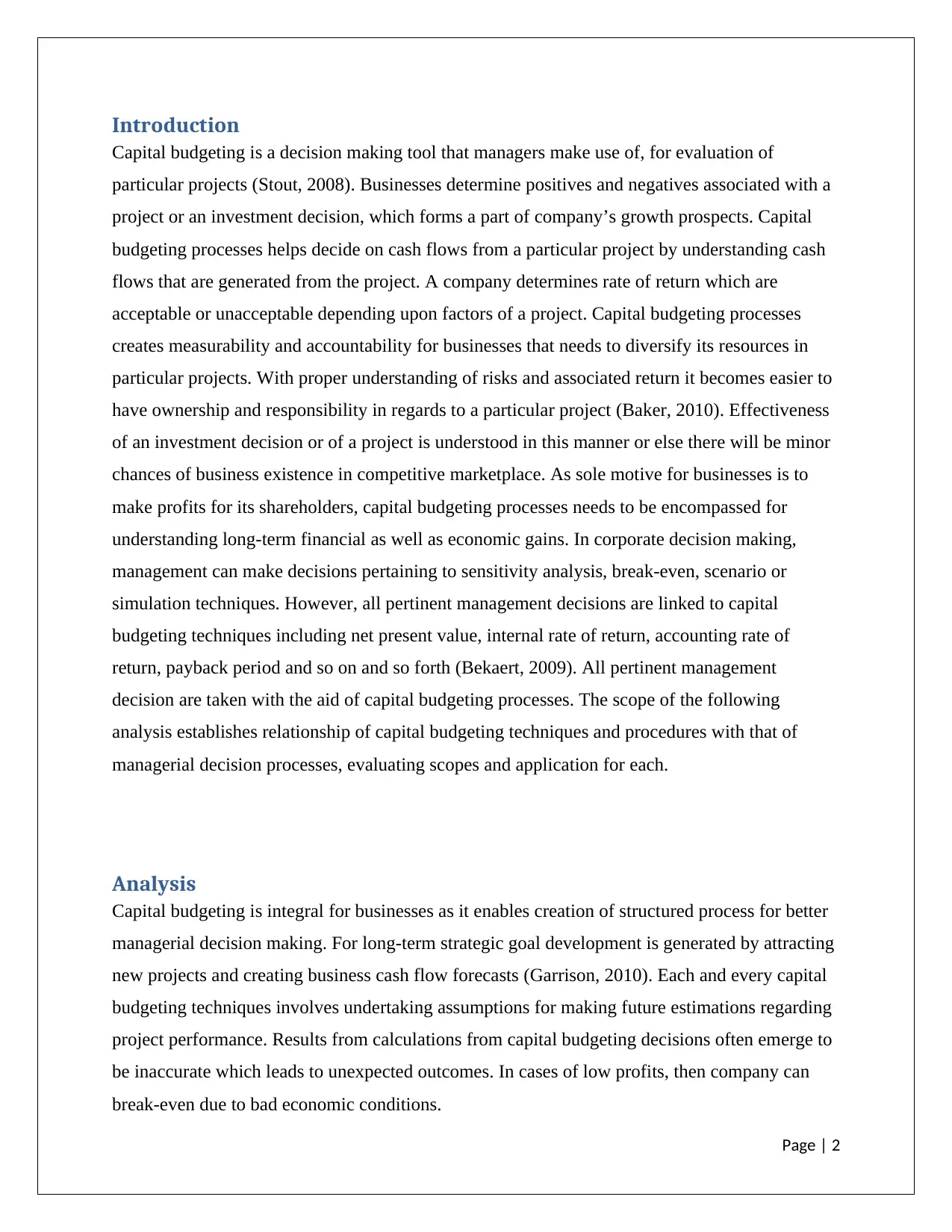
Introduction
Capital budgeting is a decision making tool that managers make use of, for evaluation of
particular projects (Stout, 2008). Businesses determine positives and negatives associated with a
project or an investment decision, which forms a part of company’s growth prospects. Capital
budgeting processes helps decide on cash flows from a particular project by understanding cash
flows that are generated from the project. A company determines rate of return which are
acceptable or unacceptable depending upon factors of a project. Capital budgeting processes
creates measurability and accountability for businesses that needs to diversify its resources in
particular projects. With proper understanding of risks and associated return it becomes easier to
have ownership and responsibility in regards to a particular project (Baker, 2010). Effectiveness
of an investment decision or of a project is understood in this manner or else there will be minor
chances of business existence in competitive marketplace. As sole motive for businesses is to
make profits for its shareholders, capital budgeting processes needs to be encompassed for
understanding long-term financial as well as economic gains. In corporate decision making,
management can make decisions pertaining to sensitivity analysis, break-even, scenario or
simulation techniques. However, all pertinent management decisions are linked to capital
budgeting techniques including net present value, internal rate of return, accounting rate of
return, payback period and so on and so forth (Bekaert, 2009). All pertinent management
decision are taken with the aid of capital budgeting processes. The scope of the following
analysis establishes relationship of capital budgeting techniques and procedures with that of
managerial decision processes, evaluating scopes and application for each.
Analysis
Capital budgeting is integral for businesses as it enables creation of structured process for better
managerial decision making. For long-term strategic goal development is generated by attracting
new projects and creating business cash flow forecasts (Garrison, 2010). Each and every capital
budgeting techniques involves undertaking assumptions for making future estimations regarding
project performance. Results from calculations from capital budgeting decisions often emerge to
be inaccurate which leads to unexpected outcomes. In cases of low profits, then company can
break-even due to bad economic conditions.
Page | 2
Capital budgeting is a decision making tool that managers make use of, for evaluation of
particular projects (Stout, 2008). Businesses determine positives and negatives associated with a
project or an investment decision, which forms a part of company’s growth prospects. Capital
budgeting processes helps decide on cash flows from a particular project by understanding cash
flows that are generated from the project. A company determines rate of return which are
acceptable or unacceptable depending upon factors of a project. Capital budgeting processes
creates measurability and accountability for businesses that needs to diversify its resources in
particular projects. With proper understanding of risks and associated return it becomes easier to
have ownership and responsibility in regards to a particular project (Baker, 2010). Effectiveness
of an investment decision or of a project is understood in this manner or else there will be minor
chances of business existence in competitive marketplace. As sole motive for businesses is to
make profits for its shareholders, capital budgeting processes needs to be encompassed for
understanding long-term financial as well as economic gains. In corporate decision making,
management can make decisions pertaining to sensitivity analysis, break-even, scenario or
simulation techniques. However, all pertinent management decisions are linked to capital
budgeting techniques including net present value, internal rate of return, accounting rate of
return, payback period and so on and so forth (Bekaert, 2009). All pertinent management
decision are taken with the aid of capital budgeting processes. The scope of the following
analysis establishes relationship of capital budgeting techniques and procedures with that of
managerial decision processes, evaluating scopes and application for each.
Analysis
Capital budgeting is integral for businesses as it enables creation of structured process for better
managerial decision making. For long-term strategic goal development is generated by attracting
new projects and creating business cash flow forecasts (Garrison, 2010). Each and every capital
budgeting techniques involves undertaking assumptions for making future estimations regarding
project performance. Results from calculations from capital budgeting decisions often emerge to
be inaccurate which leads to unexpected outcomes. In cases of low profits, then company can
break-even due to bad economic conditions.
Page | 2
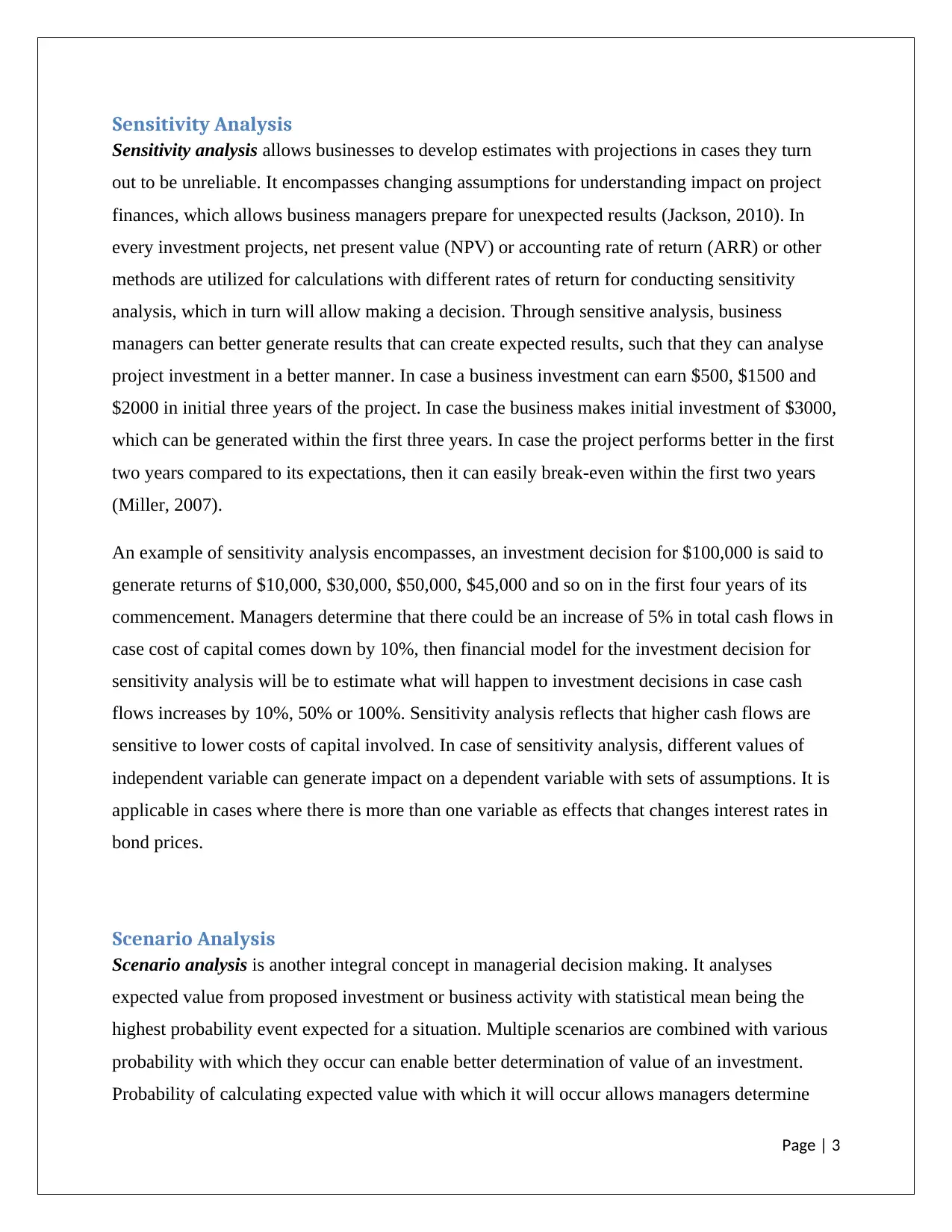
Sensitivity Analysis
Sensitivity analysis allows businesses to develop estimates with projections in cases they turn
out to be unreliable. It encompasses changing assumptions for understanding impact on project
finances, which allows business managers prepare for unexpected results (Jackson, 2010). In
every investment projects, net present value (NPV) or accounting rate of return (ARR) or other
methods are utilized for calculations with different rates of return for conducting sensitivity
analysis, which in turn will allow making a decision. Through sensitive analysis, business
managers can better generate results that can create expected results, such that they can analyse
project investment in a better manner. In case a business investment can earn $500, $1500 and
$2000 in initial three years of the project. In case the business makes initial investment of $3000,
which can be generated within the first three years. In case the project performs better in the first
two years compared to its expectations, then it can easily break-even within the first two years
(Miller, 2007).
An example of sensitivity analysis encompasses, an investment decision for $100,000 is said to
generate returns of $10,000, $30,000, $50,000, $45,000 and so on in the first four years of its
commencement. Managers determine that there could be an increase of 5% in total cash flows in
case cost of capital comes down by 10%, then financial model for the investment decision for
sensitivity analysis will be to estimate what will happen to investment decisions in case cash
flows increases by 10%, 50% or 100%. Sensitivity analysis reflects that higher cash flows are
sensitive to lower costs of capital involved. In case of sensitivity analysis, different values of
independent variable can generate impact on a dependent variable with sets of assumptions. It is
applicable in cases where there is more than one variable as effects that changes interest rates in
bond prices.
Scenario Analysis
Scenario analysis is another integral concept in managerial decision making. It analyses
expected value from proposed investment or business activity with statistical mean being the
highest probability event expected for a situation. Multiple scenarios are combined with various
probability with which they occur can enable better determination of value of an investment.
Probability of calculating expected value with which it will occur allows managers determine
Page | 3
Sensitivity analysis allows businesses to develop estimates with projections in cases they turn
out to be unreliable. It encompasses changing assumptions for understanding impact on project
finances, which allows business managers prepare for unexpected results (Jackson, 2010). In
every investment projects, net present value (NPV) or accounting rate of return (ARR) or other
methods are utilized for calculations with different rates of return for conducting sensitivity
analysis, which in turn will allow making a decision. Through sensitive analysis, business
managers can better generate results that can create expected results, such that they can analyse
project investment in a better manner. In case a business investment can earn $500, $1500 and
$2000 in initial three years of the project. In case the business makes initial investment of $3000,
which can be generated within the first three years. In case the project performs better in the first
two years compared to its expectations, then it can easily break-even within the first two years
(Miller, 2007).
An example of sensitivity analysis encompasses, an investment decision for $100,000 is said to
generate returns of $10,000, $30,000, $50,000, $45,000 and so on in the first four years of its
commencement. Managers determine that there could be an increase of 5% in total cash flows in
case cost of capital comes down by 10%, then financial model for the investment decision for
sensitivity analysis will be to estimate what will happen to investment decisions in case cash
flows increases by 10%, 50% or 100%. Sensitivity analysis reflects that higher cash flows are
sensitive to lower costs of capital involved. In case of sensitivity analysis, different values of
independent variable can generate impact on a dependent variable with sets of assumptions. It is
applicable in cases where there is more than one variable as effects that changes interest rates in
bond prices.
Scenario Analysis
Scenario analysis is another integral concept in managerial decision making. It analyses
expected value from proposed investment or business activity with statistical mean being the
highest probability event expected for a situation. Multiple scenarios are combined with various
probability with which they occur can enable better determination of value of an investment.
Probability of calculating expected value with which it will occur allows managers determine
Page | 3
⊘ This is a preview!⊘
Do you want full access?
Subscribe today to unlock all pages.

Trusted by 1+ million students worldwide
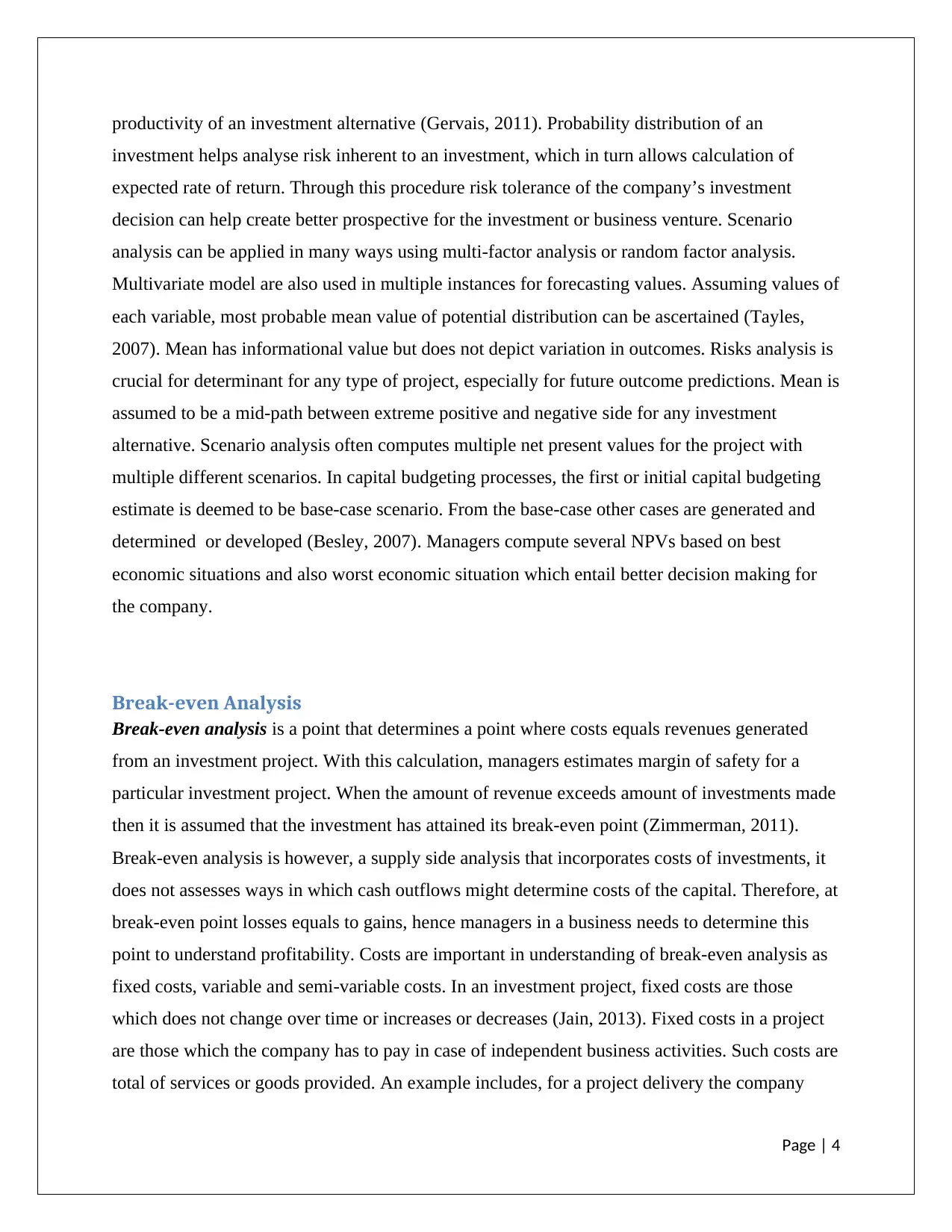
productivity of an investment alternative (Gervais, 2011). Probability distribution of an
investment helps analyse risk inherent to an investment, which in turn allows calculation of
expected rate of return. Through this procedure risk tolerance of the company’s investment
decision can help create better prospective for the investment or business venture. Scenario
analysis can be applied in many ways using multi-factor analysis or random factor analysis.
Multivariate model are also used in multiple instances for forecasting values. Assuming values of
each variable, most probable mean value of potential distribution can be ascertained (Tayles,
2007). Mean has informational value but does not depict variation in outcomes. Risks analysis is
crucial for determinant for any type of project, especially for future outcome predictions. Mean is
assumed to be a mid-path between extreme positive and negative side for any investment
alternative. Scenario analysis often computes multiple net present values for the project with
multiple different scenarios. In capital budgeting processes, the first or initial capital budgeting
estimate is deemed to be base-case scenario. From the base-case other cases are generated and
determined or developed (Besley, 2007). Managers compute several NPVs based on best
economic situations and also worst economic situation which entail better decision making for
the company.
Break-even Analysis
Break-even analysis is a point that determines a point where costs equals revenues generated
from an investment project. With this calculation, managers estimates margin of safety for a
particular investment project. When the amount of revenue exceeds amount of investments made
then it is assumed that the investment has attained its break-even point (Zimmerman, 2011).
Break-even analysis is however, a supply side analysis that incorporates costs of investments, it
does not assesses ways in which cash outflows might determine costs of the capital. Therefore, at
break-even point losses equals to gains, hence managers in a business needs to determine this
point to understand profitability. Costs are important in understanding of break-even analysis as
fixed costs, variable and semi-variable costs. In an investment project, fixed costs are those
which does not change over time or increases or decreases (Jain, 2013). Fixed costs in a project
are those which the company has to pay in case of independent business activities. Such costs are
total of services or goods provided. An example includes, for a project delivery the company
Page | 4
investment helps analyse risk inherent to an investment, which in turn allows calculation of
expected rate of return. Through this procedure risk tolerance of the company’s investment
decision can help create better prospective for the investment or business venture. Scenario
analysis can be applied in many ways using multi-factor analysis or random factor analysis.
Multivariate model are also used in multiple instances for forecasting values. Assuming values of
each variable, most probable mean value of potential distribution can be ascertained (Tayles,
2007). Mean has informational value but does not depict variation in outcomes. Risks analysis is
crucial for determinant for any type of project, especially for future outcome predictions. Mean is
assumed to be a mid-path between extreme positive and negative side for any investment
alternative. Scenario analysis often computes multiple net present values for the project with
multiple different scenarios. In capital budgeting processes, the first or initial capital budgeting
estimate is deemed to be base-case scenario. From the base-case other cases are generated and
determined or developed (Besley, 2007). Managers compute several NPVs based on best
economic situations and also worst economic situation which entail better decision making for
the company.
Break-even Analysis
Break-even analysis is a point that determines a point where costs equals revenues generated
from an investment project. With this calculation, managers estimates margin of safety for a
particular investment project. When the amount of revenue exceeds amount of investments made
then it is assumed that the investment has attained its break-even point (Zimmerman, 2011).
Break-even analysis is however, a supply side analysis that incorporates costs of investments, it
does not assesses ways in which cash outflows might determine costs of the capital. Therefore, at
break-even point losses equals to gains, hence managers in a business needs to determine this
point to understand profitability. Costs are important in understanding of break-even analysis as
fixed costs, variable and semi-variable costs. In an investment project, fixed costs are those
which does not change over time or increases or decreases (Jain, 2013). Fixed costs in a project
are those which the company has to pay in case of independent business activities. Such costs are
total of services or goods provided. An example includes, for a project delivery the company
Page | 4
Paraphrase This Document
Need a fresh take? Get an instant paraphrase of this document with our AI Paraphraser
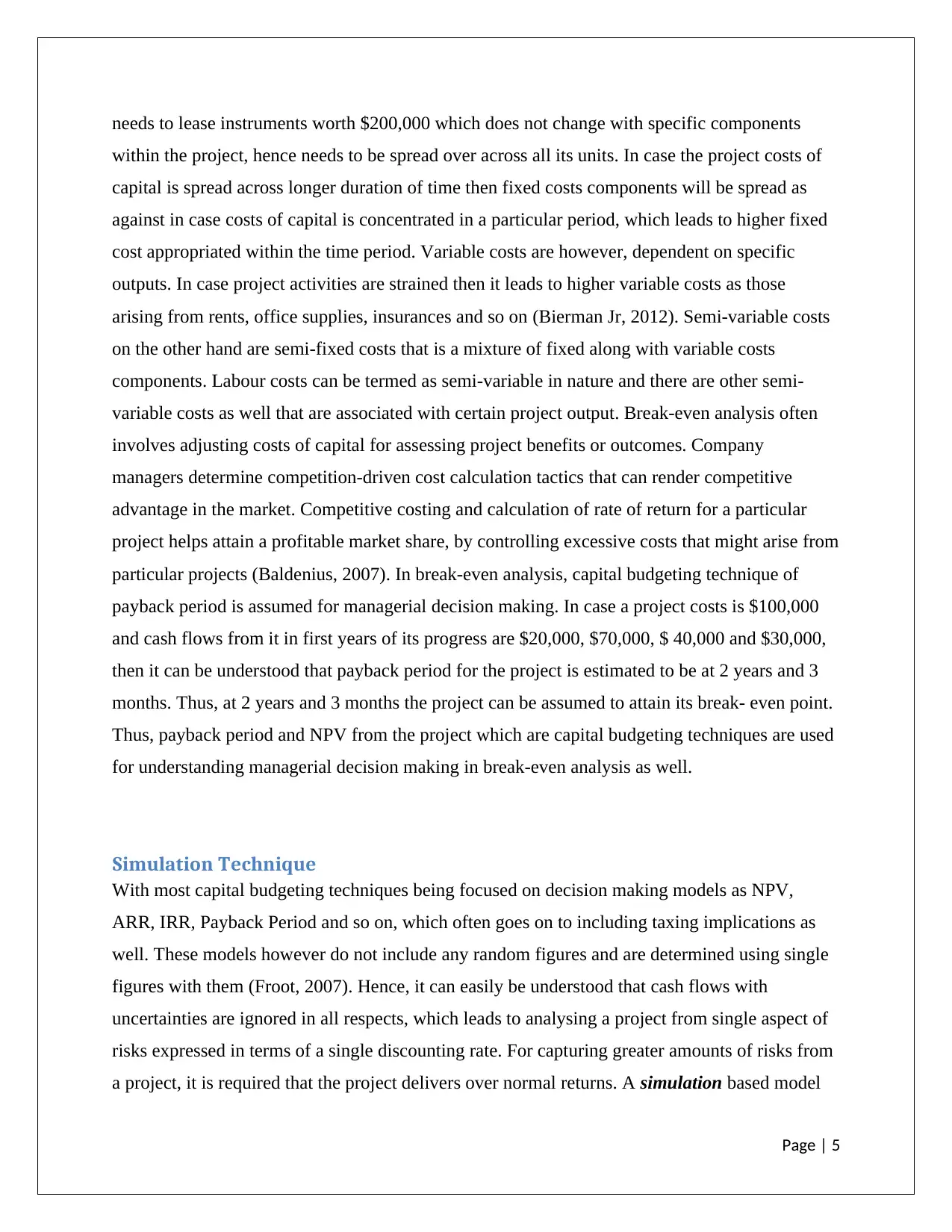
needs to lease instruments worth $200,000 which does not change with specific components
within the project, hence needs to be spread over across all its units. In case the project costs of
capital is spread across longer duration of time then fixed costs components will be spread as
against in case costs of capital is concentrated in a particular period, which leads to higher fixed
cost appropriated within the time period. Variable costs are however, dependent on specific
outputs. In case project activities are strained then it leads to higher variable costs as those
arising from rents, office supplies, insurances and so on (Bierman Jr, 2012). Semi-variable costs
on the other hand are semi-fixed costs that is a mixture of fixed along with variable costs
components. Labour costs can be termed as semi-variable in nature and there are other semi-
variable costs as well that are associated with certain project output. Break-even analysis often
involves adjusting costs of capital for assessing project benefits or outcomes. Company
managers determine competition-driven cost calculation tactics that can render competitive
advantage in the market. Competitive costing and calculation of rate of return for a particular
project helps attain a profitable market share, by controlling excessive costs that might arise from
particular projects (Baldenius, 2007). In break-even analysis, capital budgeting technique of
payback period is assumed for managerial decision making. In case a project costs is $100,000
and cash flows from it in first years of its progress are $20,000, $70,000, $ 40,000 and $30,000,
then it can be understood that payback period for the project is estimated to be at 2 years and 3
months. Thus, at 2 years and 3 months the project can be assumed to attain its break- even point.
Thus, payback period and NPV from the project which are capital budgeting techniques are used
for understanding managerial decision making in break-even analysis as well.
Simulation Technique
With most capital budgeting techniques being focused on decision making models as NPV,
ARR, IRR, Payback Period and so on, which often goes on to including taxing implications as
well. These models however do not include any random figures and are determined using single
figures with them (Froot, 2007). Hence, it can easily be understood that cash flows with
uncertainties are ignored in all respects, which leads to analysing a project from single aspect of
risks expressed in terms of a single discounting rate. For capturing greater amounts of risks from
a project, it is required that the project delivers over normal returns. A simulation based model
Page | 5
within the project, hence needs to be spread over across all its units. In case the project costs of
capital is spread across longer duration of time then fixed costs components will be spread as
against in case costs of capital is concentrated in a particular period, which leads to higher fixed
cost appropriated within the time period. Variable costs are however, dependent on specific
outputs. In case project activities are strained then it leads to higher variable costs as those
arising from rents, office supplies, insurances and so on (Bierman Jr, 2012). Semi-variable costs
on the other hand are semi-fixed costs that is a mixture of fixed along with variable costs
components. Labour costs can be termed as semi-variable in nature and there are other semi-
variable costs as well that are associated with certain project output. Break-even analysis often
involves adjusting costs of capital for assessing project benefits or outcomes. Company
managers determine competition-driven cost calculation tactics that can render competitive
advantage in the market. Competitive costing and calculation of rate of return for a particular
project helps attain a profitable market share, by controlling excessive costs that might arise from
particular projects (Baldenius, 2007). In break-even analysis, capital budgeting technique of
payback period is assumed for managerial decision making. In case a project costs is $100,000
and cash flows from it in first years of its progress are $20,000, $70,000, $ 40,000 and $30,000,
then it can be understood that payback period for the project is estimated to be at 2 years and 3
months. Thus, at 2 years and 3 months the project can be assumed to attain its break- even point.
Thus, payback period and NPV from the project which are capital budgeting techniques are used
for understanding managerial decision making in break-even analysis as well.
Simulation Technique
With most capital budgeting techniques being focused on decision making models as NPV,
ARR, IRR, Payback Period and so on, which often goes on to including taxing implications as
well. These models however do not include any random figures and are determined using single
figures with them (Froot, 2007). Hence, it can easily be understood that cash flows with
uncertainties are ignored in all respects, which leads to analysing a project from single aspect of
risks expressed in terms of a single discounting rate. For capturing greater amounts of risks from
a project, it is required that the project delivers over normal returns. A simulation based model
Page | 5
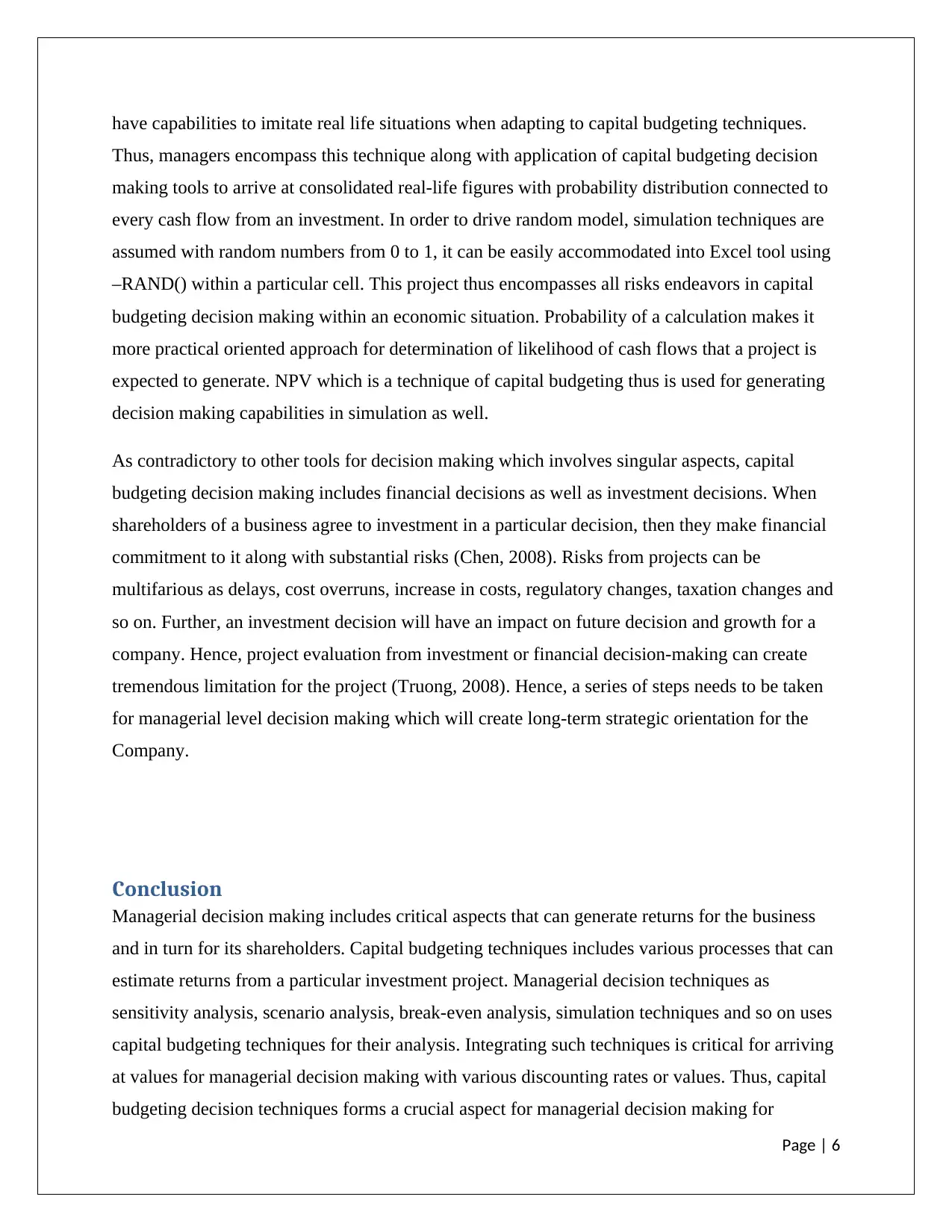
have capabilities to imitate real life situations when adapting to capital budgeting techniques.
Thus, managers encompass this technique along with application of capital budgeting decision
making tools to arrive at consolidated real-life figures with probability distribution connected to
every cash flow from an investment. In order to drive random model, simulation techniques are
assumed with random numbers from 0 to 1, it can be easily accommodated into Excel tool using
–RAND() within a particular cell. This project thus encompasses all risks endeavors in capital
budgeting decision making within an economic situation. Probability of a calculation makes it
more practical oriented approach for determination of likelihood of cash flows that a project is
expected to generate. NPV which is a technique of capital budgeting thus is used for generating
decision making capabilities in simulation as well.
As contradictory to other tools for decision making which involves singular aspects, capital
budgeting decision making includes financial decisions as well as investment decisions. When
shareholders of a business agree to investment in a particular decision, then they make financial
commitment to it along with substantial risks (Chen, 2008). Risks from projects can be
multifarious as delays, cost overruns, increase in costs, regulatory changes, taxation changes and
so on. Further, an investment decision will have an impact on future decision and growth for a
company. Hence, project evaluation from investment or financial decision-making can create
tremendous limitation for the project (Truong, 2008). Hence, a series of steps needs to be taken
for managerial level decision making which will create long-term strategic orientation for the
Company.
Conclusion
Managerial decision making includes critical aspects that can generate returns for the business
and in turn for its shareholders. Capital budgeting techniques includes various processes that can
estimate returns from a particular investment project. Managerial decision techniques as
sensitivity analysis, scenario analysis, break-even analysis, simulation techniques and so on uses
capital budgeting techniques for their analysis. Integrating such techniques is critical for arriving
at values for managerial decision making with various discounting rates or values. Thus, capital
budgeting decision techniques forms a crucial aspect for managerial decision making for
Page | 6
Thus, managers encompass this technique along with application of capital budgeting decision
making tools to arrive at consolidated real-life figures with probability distribution connected to
every cash flow from an investment. In order to drive random model, simulation techniques are
assumed with random numbers from 0 to 1, it can be easily accommodated into Excel tool using
–RAND() within a particular cell. This project thus encompasses all risks endeavors in capital
budgeting decision making within an economic situation. Probability of a calculation makes it
more practical oriented approach for determination of likelihood of cash flows that a project is
expected to generate. NPV which is a technique of capital budgeting thus is used for generating
decision making capabilities in simulation as well.
As contradictory to other tools for decision making which involves singular aspects, capital
budgeting decision making includes financial decisions as well as investment decisions. When
shareholders of a business agree to investment in a particular decision, then they make financial
commitment to it along with substantial risks (Chen, 2008). Risks from projects can be
multifarious as delays, cost overruns, increase in costs, regulatory changes, taxation changes and
so on. Further, an investment decision will have an impact on future decision and growth for a
company. Hence, project evaluation from investment or financial decision-making can create
tremendous limitation for the project (Truong, 2008). Hence, a series of steps needs to be taken
for managerial level decision making which will create long-term strategic orientation for the
Company.
Conclusion
Managerial decision making includes critical aspects that can generate returns for the business
and in turn for its shareholders. Capital budgeting techniques includes various processes that can
estimate returns from a particular investment project. Managerial decision techniques as
sensitivity analysis, scenario analysis, break-even analysis, simulation techniques and so on uses
capital budgeting techniques for their analysis. Integrating such techniques is critical for arriving
at values for managerial decision making with various discounting rates or values. Thus, capital
budgeting decision techniques forms a crucial aspect for managerial decision making for
Page | 6
⊘ This is a preview!⊘
Do you want full access?
Subscribe today to unlock all pages.

Trusted by 1+ million students worldwide

estimating future cash flows. It facilitates transfer of information for various investment projects,
which are in turn required for acquiring new investment projects. It also facilitates monitoring
and controlling of expenditures for long-term strategic decision making.
Page | 7
which are in turn required for acquiring new investment projects. It also facilitates monitoring
and controlling of expenditures for long-term strategic decision making.
Page | 7
Paraphrase This Document
Need a fresh take? Get an instant paraphrase of this document with our AI Paraphraser
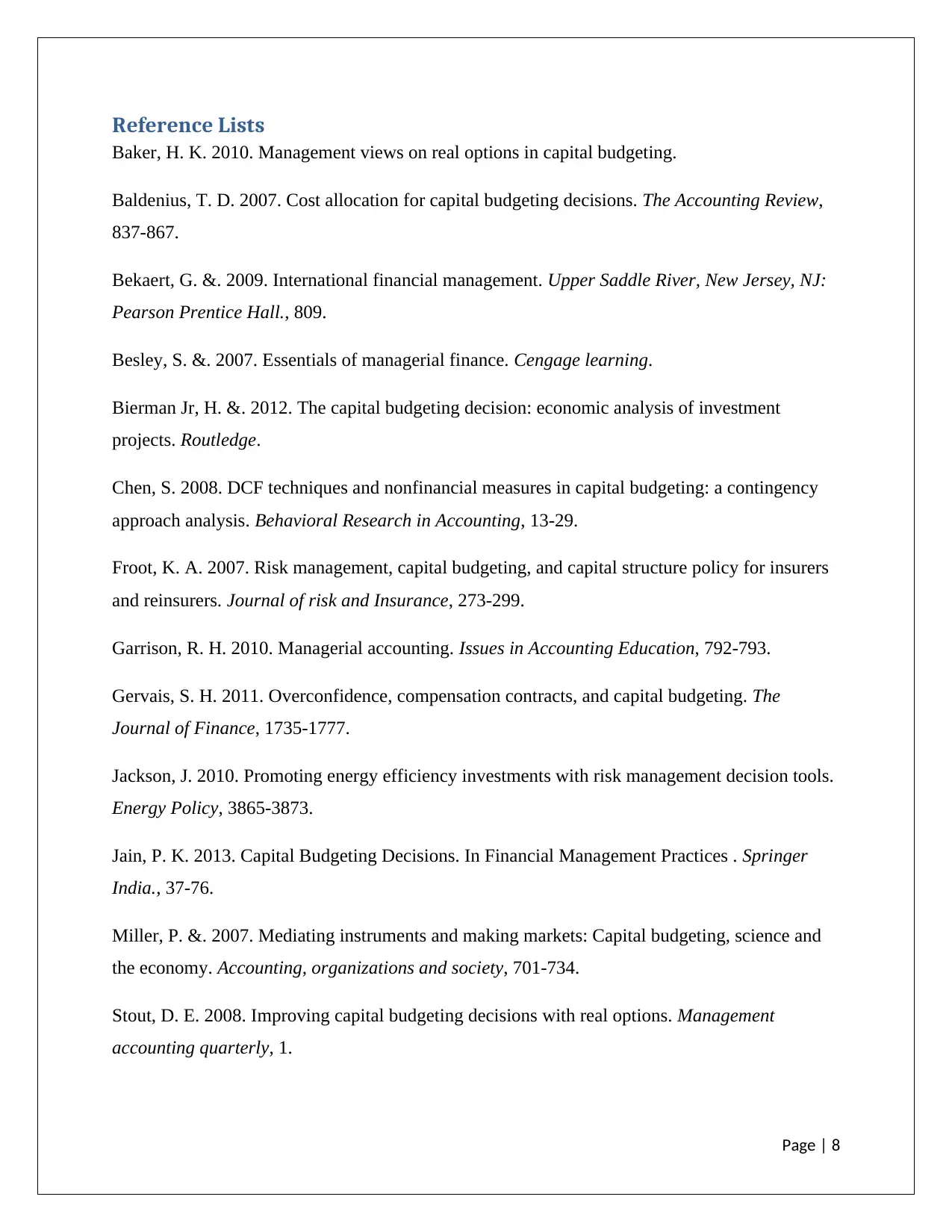
Reference Lists
Baker, H. K. 2010. Management views on real options in capital budgeting.
Baldenius, T. D. 2007. Cost allocation for capital budgeting decisions. The Accounting Review,
837-867.
Bekaert, G. &. 2009. International financial management. Upper Saddle River, New Jersey, NJ:
Pearson Prentice Hall., 809.
Besley, S. &. 2007. Essentials of managerial finance. Cengage learning.
Bierman Jr, H. &. 2012. The capital budgeting decision: economic analysis of investment
projects. Routledge.
Chen, S. 2008. DCF techniques and nonfinancial measures in capital budgeting: a contingency
approach analysis. Behavioral Research in Accounting, 13-29.
Froot, K. A. 2007. Risk management, capital budgeting, and capital structure policy for insurers
and reinsurers. Journal of risk and Insurance, 273-299.
Garrison, R. H. 2010. Managerial accounting. Issues in Accounting Education, 792-793.
Gervais, S. H. 2011. Overconfidence, compensation contracts, and capital budgeting. The
Journal of Finance, 1735-1777.
Jackson, J. 2010. Promoting energy efficiency investments with risk management decision tools.
Energy Policy, 3865-3873.
Jain, P. K. 2013. Capital Budgeting Decisions. In Financial Management Practices . Springer
India., 37-76.
Miller, P. &. 2007. Mediating instruments and making markets: Capital budgeting, science and
the economy. Accounting, organizations and society, 701-734.
Stout, D. E. 2008. Improving capital budgeting decisions with real options. Management
accounting quarterly, 1.
Page | 8
Baker, H. K. 2010. Management views on real options in capital budgeting.
Baldenius, T. D. 2007. Cost allocation for capital budgeting decisions. The Accounting Review,
837-867.
Bekaert, G. &. 2009. International financial management. Upper Saddle River, New Jersey, NJ:
Pearson Prentice Hall., 809.
Besley, S. &. 2007. Essentials of managerial finance. Cengage learning.
Bierman Jr, H. &. 2012. The capital budgeting decision: economic analysis of investment
projects. Routledge.
Chen, S. 2008. DCF techniques and nonfinancial measures in capital budgeting: a contingency
approach analysis. Behavioral Research in Accounting, 13-29.
Froot, K. A. 2007. Risk management, capital budgeting, and capital structure policy for insurers
and reinsurers. Journal of risk and Insurance, 273-299.
Garrison, R. H. 2010. Managerial accounting. Issues in Accounting Education, 792-793.
Gervais, S. H. 2011. Overconfidence, compensation contracts, and capital budgeting. The
Journal of Finance, 1735-1777.
Jackson, J. 2010. Promoting energy efficiency investments with risk management decision tools.
Energy Policy, 3865-3873.
Jain, P. K. 2013. Capital Budgeting Decisions. In Financial Management Practices . Springer
India., 37-76.
Miller, P. &. 2007. Mediating instruments and making markets: Capital budgeting, science and
the economy. Accounting, organizations and society, 701-734.
Stout, D. E. 2008. Improving capital budgeting decisions with real options. Management
accounting quarterly, 1.
Page | 8

Tayles, M. P. 2007. Intellectual capital, management accounting practices and corporate
performance: perceptions of managers. Accounting, Auditing & Accountability Journal, 522-548.
Truong, G. P. 2008. Cost-of-capital estimation and capital-budgeting practice in Australia.
Australian journal of management, 95-121.
Zimmerman, J. L.-Z. 2011. Accounting for decision making and control. Issues in Accounting
Education, 258-259.
Page | 9
performance: perceptions of managers. Accounting, Auditing & Accountability Journal, 522-548.
Truong, G. P. 2008. Cost-of-capital estimation and capital-budgeting practice in Australia.
Australian journal of management, 95-121.
Zimmerman, J. L.-Z. 2011. Accounting for decision making and control. Issues in Accounting
Education, 258-259.
Page | 9
⊘ This is a preview!⊘
Do you want full access?
Subscribe today to unlock all pages.

Trusted by 1+ million students worldwide
1 out of 9
Related Documents
Your All-in-One AI-Powered Toolkit for Academic Success.
+13062052269
info@desklib.com
Available 24*7 on WhatsApp / Email
![[object Object]](/_next/static/media/star-bottom.7253800d.svg)
Unlock your academic potential
Copyright © 2020–2025 A2Z Services. All Rights Reserved. Developed and managed by ZUCOL.





